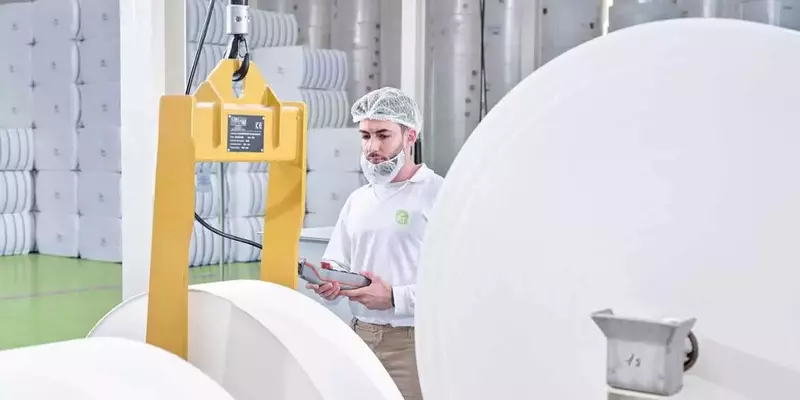Duni Group, the Swedish leader in tableware for the restaurant and hotel industries, has this year launched a range of premium napkins based on airlaid nonwovens that are fossil-free, fully renewable and available in a range of colours thanks to the innovation of INDEX™23 exhibitor OrganoClick.
The Bio Dunisoft premium napkins are bound together by OrganoClick’s OC-BioBinder, which is derived from lemon peel, corn, potatoes and other food waste. OrganoClick has won several awards for its development of renewable and functional cellulose-based materials. Through natural chemistry solutions it is enabling a wide range of products in the textiles, wood and bio composite industries to become biodegradable, non-toxic and compostable.
“We are very proud of our collaboration with Duni which has resulted in the world’s first fossil-free premium napkin,” said Mårten Hellberg, CEO and co-founder of OrganoClick. “With our biobased and biodegradable binders we are enabling our customers to end their dependency on oil-based plastics and release zero microplastics. Duni BioSoft is a great example of real circular design and has now entered into the true bioeconomy.”
Lemon peel and potatoes
“It’s a small step for lemon peel and potatoes, but a big step for the industry,” added Emma Björnhammer, Duni Product Team Manager. “We are used to food residues ending up on napkins at mealtimes, but now they are in the napkins even before they are put on the table. These are our most important launches in ten years and part of our long-term plan to increase the use of renewable materials, phase out all fossil plastics from tour product portfolio and to be a fully circular business by 2030.”
Cellulose
Compared to competing technologies, airlaid manufacturing represents a small share of nonwovens capacity globally but is responsible for some unique products based on natural wood fibres from cellulosic pulp. The process involves mixing randomly oriented short fibres with air to form a uniform mixture, that is then deposited on an air-permeable moving roll or conductor. Formation can involve exploiting temperature and heat alone, using latex as a binder, or by hydrogen bonding involving special temperature and pressure conditions with high humidity.
The resulting airlaid nonwovens have unique physical features such as high elasticity, softness, very high liquid absorption and excellent liquid retention performance. They are employed in absorbent hygiene components, wet wipes and medical products, in addition to tableware and food packaging applications.
GlatPure
A leader in the field of airlaid nonwovens production is Glatfelter which has also worked with OrganoClick on the development of biobased and home-compostable airlaid materials. In June this year, Glatfelter’s GlatPure acquisition and distribution layers (ADLs) and absorbent cores received Class 4 OK Biobased certification from TUV Austria, with the biobased carbon content of both fabrics recorded at 100%.
The OK Biobased certification from TUV Austria is a recognised global standard for verifying the biobased content of products and guarantees that the certified products are derived from renewable sources and meet stringent criteria. GlatPure ADLs and absorbent cores are manufactured with renewable plant-based raw materials and integral components of Glatfelter’s menstrual care products, designed to provide exceptional performance and comfort while minimising the environmental impact.
Airgel
Italy’s Magic Srl meanwhile claimed an INDEX™ Innovation Award back in 2017 for its development of its patented Spongel bio-based superabsorbent polymer powder and has subsequently invested in a Campen airlaid line which has led to the introduction of the company’s Airgel g-grade fully compostable pads for food packaging. In food pads, airlaid is the primary nonwoven used to absorb liquid from perishables like meat and fruit, to keep them fresh and extend shelf life, while also reducing food waste.
Based solely on renewable materials, without the use of thermoplastic fibres as is standard, Magic’s Airgel g-grade pads absorb more than 20 times their weight, with retention levels 15-20% higher than products employing superabsorbent fibres and 30% higher than other cellulose-based products at much lighter weights – delivering considerable advantages in terms of production, logistics and environment.
“The high-tech airlaid machine from Campen transformed us from a converting company into a production company, as well as making it possible for us to create Airgel g-grade pads,” said CEO Mauro Giani.
Technology
In the latest news on the airlaid technology front, Dan-Web has just been acquired by international technology group Andritz.
Based in Galten, Denmark, Dan-Web is a major supplier of a wide range of technologies for the production of airlaid nonwovens. The deal will see Andritz add competence in airlaid technology to its comprehensive product portfolio, which already includes air-through bonding, needlepunch, spunlace, spunbond, wetlaid/Wetlace, as well as converting of nonwovens, textile finishing, textile recycling and natural fibre processing technologies.
The Danish firm’s product range will also enable Andritz to participate in the drylaid cellulose process for the production of environmentally friendly packaging and single-use products.
Dan-Web is a leading supplier of hammer mills and forming head technologies for these pulp-based applications, which fits well with Andritz expertise in pulp technologies. “After more than two decades of successful collaboration, we have now decided to move closer together, which will allow both companies to further develop certain processes much faster,” said Andreas Lukas, Head of Andritz Nonwoven.
Bright future
The future certainly looks bright for airlaid nonwovens, with sustainability a key driver for growth. With raw material bases that are generally around three quarters fluff pulp, cultivated from softwood trees, these nonwovens are biodegradable and based on one of the lowest cost raw materials, while airlaid manufacturing is one of the least energy-intensive processes and uses little water and few chemicals.
New potential applications for heavier airlaid substrates in packaging, insulation and moulded consumer products are now arising and economically viable, while the push to replace single-use plastics is leading to further new opportunities in items such as food trays, cutlery, and cup lids.




















